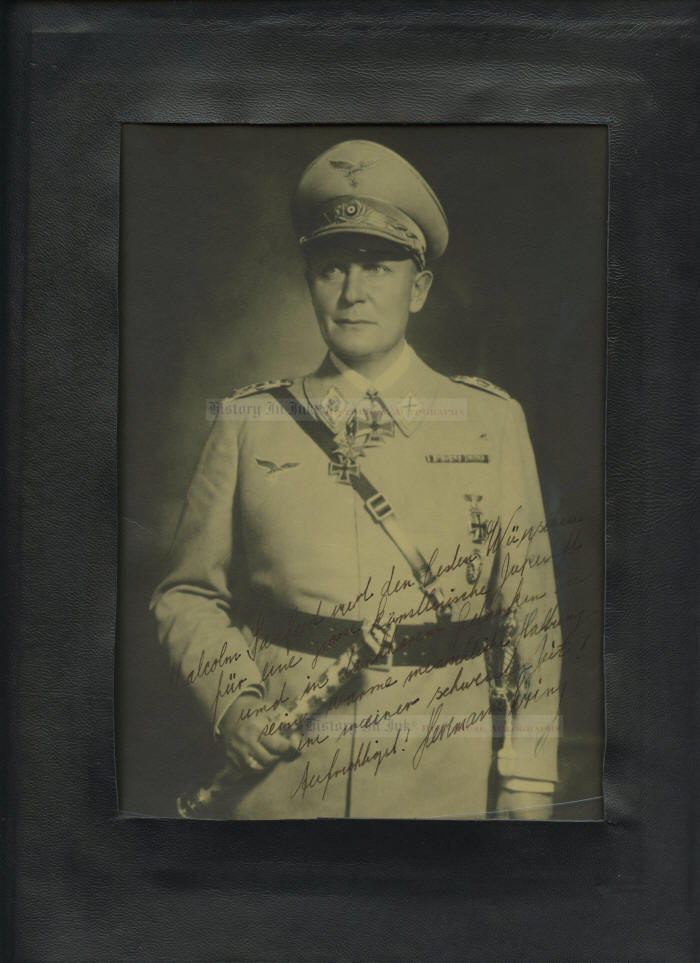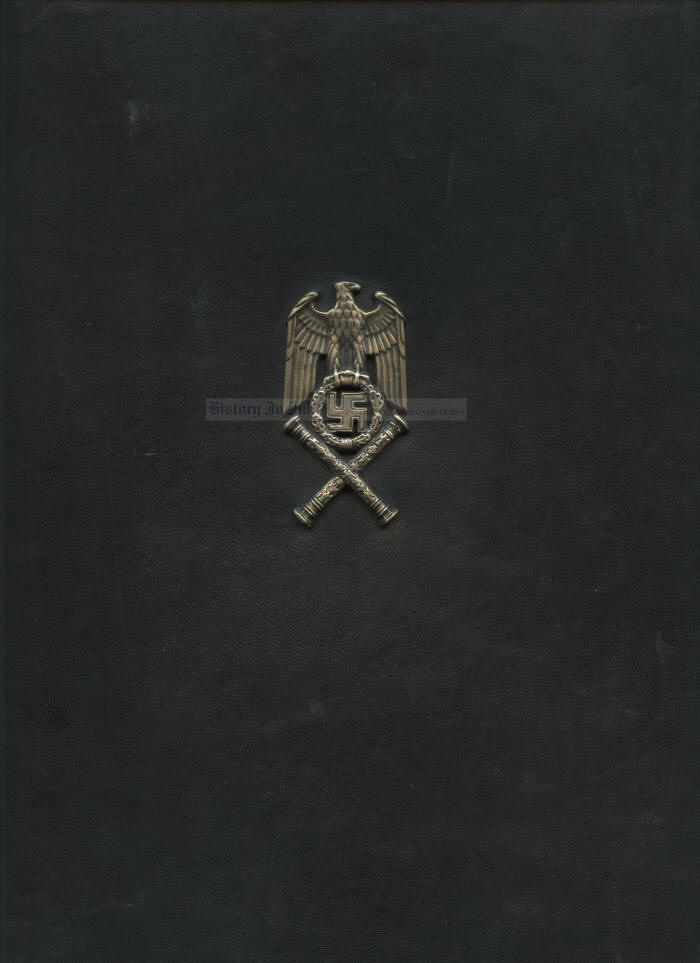



1223201
Hermann Göring
Scroll down to see images of the item below the description
Magnificent presentation photo of Göring,
inscribed and signed to a guard
who held the keys to the baggage room
where Göring’s suicide poison was hidden
Hermann Wilhelm Göring, 1893–1946. Nazi Reichsmarshall; Luftwaffe commander-in-chief. Superb association portrait photograph of Göring, inscribed in German and signed Hermann Göring, in Göring’s personal leather presentation portfolio.
Imprisoned by the Allies near the end of World War II, Göring secretly kept at least two vials of potassium cyanide with which he might commit suicide. He sought to befriend the guards whom he might then convince to give him access to the inmates’ baggage room, where the poison was stored. One of the guards who had responsibility for Göring after his capture was First Lt. Malcolm Sanford. An American soldier, Sanford guarded Göring at Mondorf-les-Bains, Luxembourg, the site of a temporary prisoner of war detention facility at the Palace Hotel, and later at Nuremberg, where Göring was held for the war crimes trials in 1946.
Göring has inscribed this photograph with a long, six-line inscription implicating his imprisonment, which he calls his “most difficult time,” and acknowledging the humanity of his guard. He writes, in full: “Malcolm Sanford mit den besten Wünschen für eine grosse künstlerische Zukunft und in dankbaren Gedenken an seine warme menschliche Haltung in meiner schwersten Zeit. Aufrichtigst! Hermann Göring” In English, he writes: “Malcolm Sanford with the best wishes for a great artistic future and in grateful memory of his warm human attitude in my most difficult time. Most sincerely! Hermann Göring”
The late Dr. John K. Lattimer, a U.S. Army surgeon who was a consulting physician at Nuremberg, knew more about the Nazi inmate defendants and their guards than anyone else who has written on the subject. Lattimer notes the vast array of personal belongings that Göring had with him when he was captured and writes of Göring’s sycophancy toward the guards. Göring, he says, brought with him to Mondorf “a huge amount of baggage and personal effects. He had clearly expected to be interned in a neutral country the way the Kaiser had been after World War I. He had started out with seventeen vehicles filled with all manner of luxurious trappings such as crystal ware, ornate linens, silver, and other accouterments for regal living . . . .” John K. Lattimer, Hitler’s Fatal Sickness and Other Secrets of the Nazi Leaders 81–89 (1999). Göring gave Sanford a solid gold cover for a book of paper matches. The cover bore an image of the Luftwaffe eagle set in diamonds and clutching a Nazi swastika set with rubies in its talons. Göring also inscribed and signed one other photograph to Sanford on August 8, 1945—a photograph of Göring, his wife, and his child that he inscribed on the back to Sanford with his “full trust and gratitude.” Göring “had worked hard to ‘butter-up’” Sanford, Lattimer writes, and “could be very charming, and was very interesting in his conversations, so he could attract anyone he chose to work on.”
Göring’s reasons became obvious after his suicide. Göring apparently kept his vials of potassium cyanide hidden in jars of skin cream. According to Lattimer, at their first meeting Göring mentioned to another physician that he had a skin condition that required considerable attention. His skin was chafed because his fat thighs rubbed together. After he lost weight, though, and the chafing stopped, Göring continued to talk of the condition. “When I pointed out he no longer had a skin condition,” Lattimer writes, “he responded, ‘That is because I take such good care of it with my skin cream.’ This sounded reasonable, and assured his access to jars of skin cream in his luggage whenever he asked for it.” Id. at 69. Lattimer continues:
We have notes written to Lt. Sanford from Göring asking permission for Göring to get from the baggage room, his large blue leather-covered notebook, his sponge, comb, mouthwash and shaving materials . . . . He certainly got the distinctive blue notebook, with which he later appeared in court. He obviously knew he would not get his entire toilet case, with its scissors and razors, but in getting the notebook he ‘opened-the-door’ to the concept of easy and legitimate access to his baggage.
Id. at 84.
But the skin cream was a ruse, for it hid the cyanide vials:
Göring had been observed to be toying with several of these brass, cyanide capsule containers during the last weeks of the war. When he surrendered to the Allies, he had one of the brass, ampoule containers in a can of loose coffee crystals where it was found very quickly by the guards. This caused everybody to relax, because they thought they had found his only suicide capsule. He had also hidden two of the capsules in jars of opaque face cream in his case of toilet articles. It was this skin cream to which he asked to have access at various times, obviously as a dry run. He carefully developed a long succession of requests for his skin cream and it was apparently given to him whenever he requested it. Lt. Sanford had obliged him earlier, as had Dr. Kelley. He would return it promptly so that there would be no problem. The mechanism for access to anything in the baggage room was easy . . . .
Id. at 101–02. Ultimately, Sanford was transferred away from Nuremberg, and Göring had to woo other guards before his suicide.
This photograph is also among the items that Göring gave Sanford—undoubtedly as part of his scheme to “butter up” the American lieutenant. With getting to the cyanide vials his goal, Göring knew that his other possessions were immaterial and that he had to make friends in order to gain access to the baggage room.
This approximately 6½” x 9” photograph is magnificent. Göring has inscribed and signed it in black fountain pen. The photograph is in a leather presentation folder emblazoned with a three-dimensional metal Reichmarschall’s crest bearing the Nazi eagle, the swastika, and crossed Reichmarshall’s batons. There are a couple of insignificant creases in the middle of the photograph, not affecting either the inscription or the signature. The original celluloid cover for the photograph in the folder is broken out but is present. Overall the piece is in fine to very fine condition.
Serious autograph material from Göring’s imprisonment after World War II is rare and valuable. This presentation photograph may be the last, or one of the last, of its kind to reach the autograph market. The fact that it is inscribed and signed to Sanford makes it rarer yet, an extraordinary relic from Göring and the Nuremberg War Crimes Trials. This belongs in the finest of World War II or Third Reich collections.
We reject Nazism and all that it represented. We nevertheless offered this photograph because of its rarity and because Nazism, although despised, played a large role in the history of the 20th Century.
_____________
This item has been sold, but
click here to see other
World History items
that we are offering.



